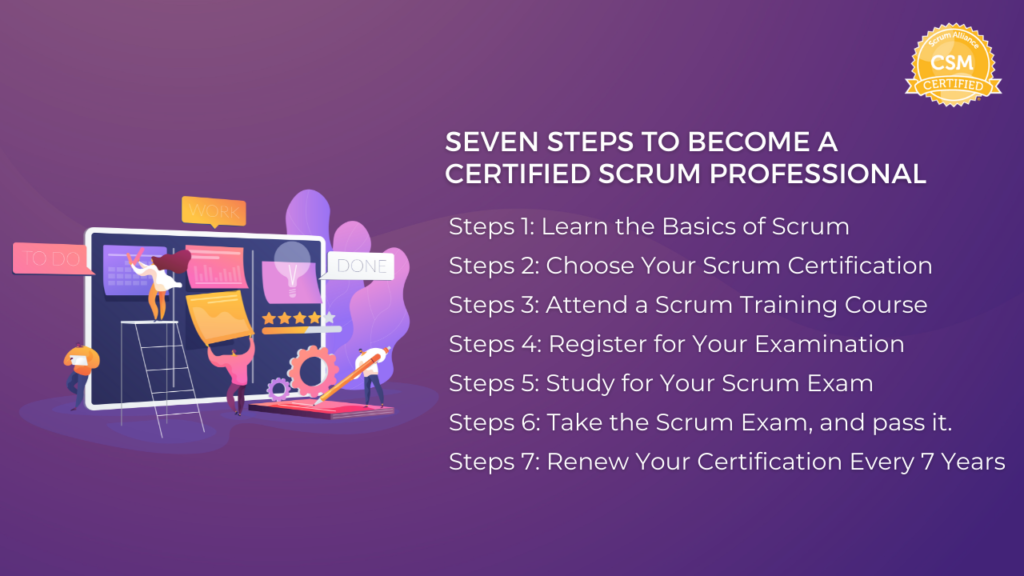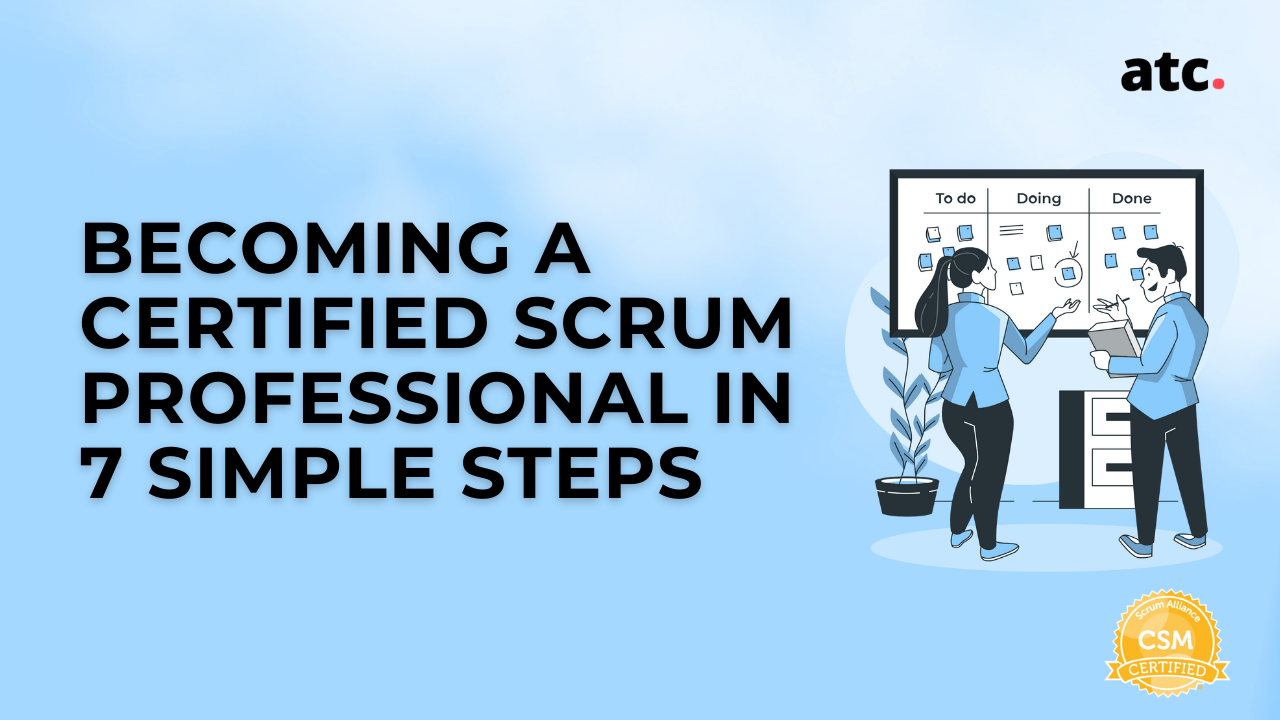Subscribe to the blog
Scrum Master Professional - The Journey
A Scrum Master is an essential role in any Agile project that relies on the Scrum framework. The Scrum Master is necessary for the facilitation of the project from start to completion. The Scrum Master is responsible for the arrangement of daily Scrum meetings, enhancing team interactions, and working to optimize and maximize team productivity by eliminating barriers to productivity for individuals serving on the development team as well as for the team as a whole. A Scrum Professional needs to have a full and complete understanding of the needs of the client company, the owner of the final project, engineers, programmers, and everyone involved.
Because he or she works directly with the development team, the Scrum Master must be able to build a quality rapport with the team members. He or she must be able to listen to the team, hear complaints, understand their perceived barriers to productivity as well as actual barriers to productivity. As such, a Scrum Professional is like a counselor for the engineering team itself. The Scrum Master’s job entails being able to spot and remove anything standing in the way of the team getting their job done and turning out valuable software products regularly, meeting the goals of specific sprints, and protecting the team from any present or potential distractions coming from outside the work environment, inside it, or from any other possible vectors.
What’s more, the Scrum Master must understand the software being developed. They must understand the needs and expectations of the end-user. While the Scrum Professional is not responsible for the shape, perimeters, or quality of the final product, he or she is responsible for keeping the team on task, focused, and working consistently with their heads fully in the game from start to completion.
While an individual Scrum Master is not technically responsible for the end product, he or she will build their reputation based on the success or failure of the teams they work with. That means, as a Scrum Master in training, it is your job to get the fullest, best, and most complete education you can possibly obtain. Because the job of the Scrum Professional is often subjective in many ways, it is only really possible to judge your work by the quality of the work the teams you oversee turn out. That being said, there is a well-established process for becoming a Scrum Master.
The process is composed of seven steps, and they are as follows;

Step 1. Learn the Basics of Scrum
Step 2. Choose Your Scrum Certification
Step 3. Attend a Scrum Training Course
Step 4. Register for Your Examination
Step 5. Study for Your Scrum Exam
Step 6. Take the Scrum Exam, and pass it.
Step 7. Renew Your Certification Every 7 Years
Learn the Basics of Scrum
Before anyone can become a qualified Scrum Master, he or she will need to become familiar with the 12 principles of the Agile process as well as the values of this dedicated software development methodology. There are many valuable resources out there that are readily available for use to obtain mastery of this complex discipline. Along with the readily available resources, you can also look through the Agile Manifesto in order to become familiar with the process.
Choose Your Scrum Certification
The best way to become a qualified Scrum Master is to select and complete a recognized program of certification. Such a program will help to ensure that you are completely and fully educated in the Agile process, the principles of Scrum, as well as all of the roles and duties that you will be expected to know, understand, and fulfill as a Scrum Master. There are numerous certification programs for you to choose from on your journey to becoming a fully qualified Scrum Master. They include, but are not limited to:
- Professional Scrum Master I (PSM I)
- Certified Scrum Master (CSM)
Once you have selected your path to certification, it will be time for you to enroll in a course of training that is recognized by the industry's regulatory bodies and leading Agile professionals. Each of the various certification options will come with requirements of its own. That means that you will have to be sure to participate in a course that is recognized and accepted by the greater Agile and Scrum community. Investing in a training course that is not recognized and accepted will result in a waste of your time and your hard-earned money.
Fortunately, this is not a common pitfall for would-be Scrum Professional, but it does occasionally happen. Therefore, we strongly encourage you to investigate the status of any training and certification program you intend to attend before signing on the dotted line. If you have any questions about the validity of a given course of study or certification program, you can contact an Agile regulatory body. They will be happy to provide you with the answers to most of your questions about Scrum courses.
Attend a Scrum Training Course
Once you have decided on the role that you wish to fulfill in the Agile process, it is time to sign up and attend your chosen course of study. Course materials have been designed and optimized over the years to deliver a high quality of accurate information and training to students. You can rest in the certainty that an accepted and sanctioned Scrum Master certification course will provide high-quality instruction as well as high-quality materials for you to review and study in your spare time. It is highly recommended that you spend at least some of your spare time studying these materials in order to avoid having to repeat the course or pay for registration a second or third time.
It is also strongly advised that you take accurate notes during your course work, collaborate with your fellow classmates to discuss the materials and information imparted during the class, and make sure that your review period involves only the information that was taught in the class that you signed up for and attended.
Register for Your Examination
Once you have completed the course and feel ready to take your final exam to be certified as a Scrum Master, it will be time to register for your Scrum Master exam. This is your opportunity to prove that you have the knowledge and the insight it takes to fill the shoes of a Scrum Master and to play an essential role in the Agile organizational process. Most Agile professionals recommend taking the exam as near to the completion of the course materials as possible. This is to help ensure that the many things you will have learned during your course of study will be fresh in your mind.
The time limit is also meant to dissuade trainees from using the time to access other sources of Scrum and Agile information which may be out of date, that may conflict with current, sanctioned processes and methods. Too many students have put off their exams, become unsure of their skills, accessed bad information, and have failed their exams as a result.
Many Agile instructional organizations set a time limit between the completion of your Scrum Master training and the time when you will eventually take the exam. In some cases, it could be 14 days, which is standard. Some will expect you to take it sooner than that, and others will allow you to take it longer. Remember, if you do not complete the exam within the allotted grace period after completing your training course, you will no longer be allowed to take the exam and will be required to take the training course again from start to completion. We would not wish that kind of frustration and additional expense on anyone. So please, take your exam as quickly as you are able to do so.
Study for Your Scrum Exam
Once you complete your course of training, it is important to do whatever you can to keep the materials fresh in your mind. While we do recommend taking the exam as soon after completing the course as possible, there may be a critical interim before you take the actual exam. During this time, we strongly recommend that you spend your time reviewing your notes taken during the course and any materials you may still have in your possession, as well as any course materials you may still have access to.
Again, we very strongly recommend that you refer only to the materials provided by your class and by your instructor or instructors, as well as your notes which you should have taken during the course. This is key to avoiding the possibility of accidentally studying materials that are not a part of the course that you took. If you look up Scrum and Agile information outside the class, there is a good chance that you will be looking at information that is out of date, wrong information, compiled by non-Agile professionals, or even by individuals who have failed the exam.
That being said, it is also essential that you take accurate notes during your course work, collaborate with your fellow classmates to discuss the materials and information imparted during the class, and make sure that your review period involves only the information that was taught in the class that you signed up for and attended.
Take the Scrum Exam, and pass it.
The actual exam that you take will be different compared to exams from different Scrum and Agile courses, and it will especially be different from exams from courses that are out of date or that are not accepted by the Agile community. More often than not, it will be a multiple-choice exam. The passing marks will usually be between 60% and 80% or better. In most cases, you will have exactly 60 minutes to complete the exam.
In most instances, you will be told within a few minutes of completing the exam whether or not you passed and what your percentage of correct answers is. After you have taken the exam and passed it, you will be given a PDF document that will serve as your proof of completion. This is your Scrum Master certificate. This is your only proof that you are in fact a trained, qualified, and recognized Scrum Master expert.
That being the case, we strongly recommend that you make a digital copy of your PDF. You may email it to yourself for safekeeping. In fact, you might email it to more than one email account that you hold to guard against accidents. Please do not print physical copies and give them out to anyone. If you do print a physical copy, it is best to print only one and to place it in a secure location, such as a frame firmly mounted to your wall, in a lockbox, or in a similar secure container. Giving copies of your certificate out may disqualify you from working as a Scrum Master, and we would not like to see that happen to any well-meaning member of our community. This is your proof that you are both qualified and certified to do this work, and you will not be able to be employed as a Scrum Master without it.
Renew Your Certification Every 2 Years
Like many other industries, such as medicine, finance, and others, the Agile and Scrum disciplines do change on a regular basis. It changes in order to remain in accord with the broader culture and to reflect values and trends which we all feel are important. It changes in response to government regulation. This is especially important for CSM certifications since this is often the basic certification requirement of regulatory bodies. But other certifications will also have a shifting relationship with regulatory bodies due to the fact that legislation is always a work in progress and can be changed at any time.
Renewal of your certification is also important due to the fact that business practices in the IT industry change and because the nature of software and computer programming languages change frequently. This is a large part of why a commitment to ongoing education is a requirement for all Agile and Scrum professionals.
Depending on the organization you work for, as well as the source of your certification, you may be required to provide proof of completion of your continuing education hours. While this may seem like an inconvenience at first, it is in the interest of everyone within the Agile and Scrum community to acknowledge and accept that without ongoing education, we simply can not remain competitive and deliver quality work to the people we serve.
Further Understanding of the Agile & Scrum Process

Becoming an Agile professional at any point in the organizational process requires in-depth study and dedication to the discipline. This involves understanding agile scrum methodologies, Agile Scrum applications, daily scrum synchronization, sprint planning, and review, as well as the production of scrum artifacts.
Any successful Scrum Master will need to have a full and complete understanding of the process. Therefore, it is important to not only complete the steps to becoming a Scrum Professional in the correct way and in the correct order, but it is also helpful and often necessary to understand the roles of the various members of an Agile team. This includes the owners of the end product, project managers, the engineers with whom you will be working directly on a daily basis, as well as the people who will be using the finished products your immediate developer team creates.
Because information technology, corporate culture, and the needs of buyers and end-users are always changing and in flux, continued dedication is one of the most important duties of the Scrum Master. Once you understand all of this and become committed to completing your Scrum Professional education and ongoing education, you will be well-positioned to serve as a Scrum Master and to lead your teams to success.




